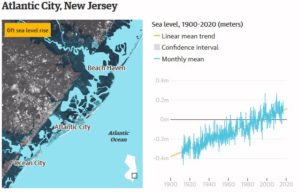by Daniel Brouse
For decades businesses located on the island of Atlantic City have been scenario planning for climate change and rising sea levels. At the turn of the century, the casinos devised a plan to float their businesses and ferry gamblers in. Now, the rising waters are no longer a scenario.
So-called “nuisance flooding” — which causes public inconveniences such as frequent road closures, overwhelmed storm drains, and compromised infrastructure — has increased on all three U.S. coasts, between 300 and 925 percent since the 1960s, according to a 2014 NOAA report
“As relative sea level increases, it no longer takes a strong storm or a hurricane to cause flooding,” said William Sweet, Ph.D., oceanographer at NOAA’s Center for Operational Oceanographic Products and Services (CO-OPS) and the report’s lead author. “Flooding now occurs with high tides in many locations due to climate-related sea level rise, land subsidence and the loss of natural barriers. The effects of rising sea levels along most of the continental U.S. coastline are only going to become more noticeable and much more severe in the coming decades, probably more so than any other climate-change related factor.”
Atlantic City, N.J. ranked third in the top ten U.S. areas that experience nuisance flooding with a 682% surge since 1957.
“It started with a thunderstorm — high tide, heavy rain — and suddenly we had 6 inches of water in the entire office,” said Yellow Cab owner Paul Rosenberg. “We thought it was a freak thing and we had to submit insurance claims for drywall.” But, it keeps happening.
“It’s these smaller events where the accumulated toll begins chipping away at infrastructure,” says William Sweet, a NOAA oceanographer who has studied nuisance flooding. “The way the public will notice the impacts of sea level rise will be through nuisance tidal flooding. What this sea level rise does is it increases everything: the mean (sea level), the height of high tides and the water levels during severe events.”
“Sandy, as devastating as it was, isn’t the greatest barometer because we have flash floods,” said Cathy Burke, who has run the Irish Pub since 1973. We can have floods at the drop of a hat. Without even realizing we’re going to have them. It’ll be raining and within seconds you’ll see flooding in the street. You don’t read about it in the paper. You don’t hear about it on the radio or television. You just have water that just comes up and if you don’t have warning and move your car, you have water in the car.”
“There is no central place that makes all the decisions, so you get one town building a pump station to push water out and another town pumping the water back to the same place,” said Rouzbeh Nazari, an environmental engineering expert at Rowan University. “It kind of feels like we’ve just given up, that we can’t do anything about it. I’m less worried about a Sandy-like event than nuisance flooding. They are losing 20 cars a month to nuisance flooding on Absecon Island. We need a regional solution but New Jersey has no specific plan to deal with it
“The Native Americans were a lot smarter than the European settlers,” said James Whalen, a former Atlantic City mayor and now state senator. “The barrier islands up and down the coast really should not have been built on, but here we are.”
A spokesman for Chris Christie said: “I don’t know what you want me to do, you want me to go down there with a mop?”
Sources: NOAA, The Guardian, The Press of Atlantic City
